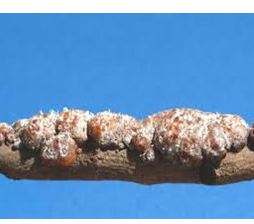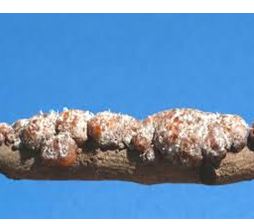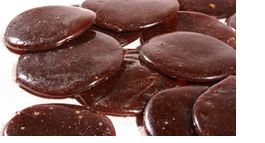Morphology, Life cycle and Economic uses of Laccifer lacca


INTRODUCTION
Lac is a natural commercial resin of animal origin. It is the secretion from a scale insect belonging to the genus laccifer (Hemiptera: Coccoidea) as a hard protective covering around its body. It has a reddish or dark brown colour with a disagreeable smell. The word “lac” is derived from a Sanskrit word which means “hundred thousand” indicating the gregarious habit of this insect. It is commonly called Shelllac and in Nepali, the laha. The insects are commercially exploited worldwide for the production of lac which has diverse industrial applications. Laccifera lacca is the common Indian lac insect. Lac is produced mainly in India, Bangladesh, Thailand, and China. India is still the largest producer of lac in the world. In Nepal also lac is produced.
SYSTEMATIC POSITION
Laccifera (=Tachardia) lacca is the most important lac producing insect of commercial importance. Its systematic position is given below:
Phylam — Arthropoda
Class — Insecta
Order — Hemiptera
Super-family — Coccoidae
Family — Lacciferidae
Genus — Laccifer
Species — lacca
MORPHOLOGY
The lac insects are sluggish and have almost sedentary life. They live inside the chambers in the tree twigs. Therefore they are degenerated, without wings but with distinct legs.
The female lac insect is larger in size and is more degenerated. It measures 4-5 mm in length. It has a bag-like body with indistinct head, thorax and abdomen. A small reduced antenna and a proboscis are present on the head. They lack eyes, legs and wings. The loss of eyes, wings, and legs are due to the fact that the female larvae after once settling down never move again. Abdomen bears a pair of caudal setae. It is the female lac insect which secretes the bulk of lac for commerce.
Fig; Male with wings Fig; Male without wingsThe male lac insect is smaller in size and red in colour. It measures 1.2-1.5 mm in length. The body is has typical three parts: head, thorax and abdomen. The head bears a pair of antennae and a pair of eyes. Mouth parts are absent so adult male insects do not take food. The thorax has three pairs of legs. Wings may or may not be found. The wing form has only one pair of wing. Abdomen is the largest part of the body bearing a pair of caudal setae and sheath containing penis at the posterior end.
LIFE CYCLE
The mature males emerge out of their chambers and crawl to the female chambers. The male enter the female chamber through anal tubular opening and fertilizes the female. After copulation, the male dies. One male is capable of fertilizing several females. Females develop rapidly after fertilization. They take more sap and exude more resin and wax forming a large sized chamber. Thus, the secretion by females mainly contributes to lac.

The life cycle includes three stages: egg, nymph and adult. A fertilized female lays 200-500 eggs by contracting its body in forward direction. Eggs are laid in the incubation chamber in which she is enclosed. Eggs are generally laid in the month of October and November. Then eggs hatches into first instar nymph. A large number of nymphs emerge and crawl over the surface of twigs and branches of plants which they infest; the number is so large that the mass emergence of nymphs is often termed as 'swarming'.
They start sucking sap from the tender, succulent twigs. At this time they are unable to feed on hard twigs. They settle very close to each other so that a twig may contain 150-200 nymphs. Soon after their settlement they start secreting a resinous substance around their body through special dermal glands present all over the body. After some time the nymph gets fully covered by the lac encasement, also known as lac cell. Once they are fully covered, metamorphosis commences.
The first instar nymph is red colored, minute, boat-shaped and is about 0.5 mm in length. Head bears paired antennae, ocelli and piercing and sucking type of mouth parts. The maxillae and mandibles together form the sucking tube or proboscis. Three segmented thorax bears two spiracles and one pair of walking legs in each segment. The abdomen bears a pair of long caudal setae. The nymph moults three times before reaching maturity; the duration of each of the three nymphal stages depends on environmental factors, such as temperature, humidity and host plant.
The male and female cells are different in shape, and can be easily distinguished sometimes later. Male cells are elongated and cigar shaped. There is a pair of branchial pores in the anterior side and a single large circular opening covered by the flap in the posterior side. It is through the posterior circular opening that the matured male lac insect emerges out of its cell.
Female cell is oval, having a pair of small branchial pores in anterior side and a single round anal tubular opening in posterior side. Through the anal tubular opening are protruding waxy white filaments, secreted by the glands in the insect body, which is an indication that the insect inside the cell is alive and is in healthy condition. These filaments also prevent the blocking of the pore during excess secretion of lac.

Now the male emerges out from its cell, moves on lac cell and enters the female cell for fertilization. In this way the life cycle is completed.
LAC SECRETION
Lac is a resinous substance secreted by certain glands present in the abdomen of the lac insects. The secretion of lac begins immediately after the larval settlement on the new and tender shoots. This secretion appears first as a shining layer which soon gets hardened after coming in contact with air.
This makes a coating around the insect and the twig on which it is residing. As the secretion continues the coating around one insect meet and fuses completely with the coating of another insect. In this way a continuous or semi-contmuous incrustation of lac is formed on the tender shoots.

HOST PLANTS
The insects live as a parasite, feeding on the sap of certain trees and shrubs. It generally infests more than 400 plant species (Sharma et al., 2006), and feeds on the host tissues such as stem and sometimes petiole. Its mouthparts are specialized for piercing the plant tissue and sucking the sap within. Unlike many plant sucking homopterans, the lac insect inserts its mouthparts only once in its life-cycle, thereafter remains sedentary and continues feeding (Imms and Chatterjee, 1915). Within few hours of their emergence, the first instar nymphs find a suitable feeding site and successfully penetrate their styletsinto the plant tissue to reach the vascular bundles. The important trees on which the lac insects breed and thrive well are – Kusum (Schleichera oleosa), Palas (Butea monosperma), Ber (Zizyphus mauritiana), Babul (Acacia arabica), Khari (Acacia catcchu), Arhar (Cajanus indicus) and peeple (Fiscus religiosa).

COMPOSITION OF LAC
Lac is a mixture of several substances, of which resin is the main constituent. Quality of lac is greatly affected by the quality of the host plant. The lac obtained from the insects is a complex substance made up of resin, dye, wax, albuminous matter, mineral matter and water. The approximate percentage of different constituents of lac is given below:
Resin – 68 to 90%
Dye – 2 to 10%
Wax – 5 to 6%
Mineral matter – 3 to 7%
Albuminous matter – 5 to 10%
Water – 2 to 3%
USES OF LAC.
Lac, the only resinous compound of animal origin has immense economic importance. No doubt the development of many synthetic products have made its importance to a little lesser degree, but still it can be included in the list of necessary articles. Lac has diverse uses.
- Lac is used in making toys, bracelets, sealing wax, gramophone records, bangles etc.
- It is by the jewelers and goldsmiths as a filling material in the hollows of gold and silver ornaments.

- It in the form of shellac is used as a furniture finish.
- Waste materials produced during the process of stick lac are used for dying purpose.
- Nail polish is a good example of the by-product of lac.
- The fluid lac dye obtained by dissolving the crushed stick-lac in water is called Alakta or Alta. This dye is applied by Indian Hindu women on hands and sole of feet.
- From the stick-lac (twigs encrusted with lac), shellac is obtained after purification. Shellac is used as coating for medicines.
- In Ayurveda, Siddha and Unani system of medicine Lac is used for treatment of variety of diseases. In Ayurveda, Lac is considered astringent (Ras/taste), cool (Veerya/potency), and Pungent (Vipaka/post-digetsive effect). It balances pitta-kapha dosh and promotes strength. In Unani, Lac is considered tonic for liver, stomach and intestine
Conclusion
The phytophagous lac insect, Laccifera lacca secretes true lac, the only natural commercial resin of animal origin. Lac is actually secreted for protection by females. It generally infests about 400 plant species and feed on the host tissues. The females are degenerated in form and feeds on the sap of its host plants. Male undergoes complete metamorphosis while female undergoes degeneration.
References
- Chattopadhyay, S. 2011. Introduction to Lac and Lac culture. Department of forest and biology and tree improvement faculty of Forestry. Birsa Agriculture University, Ranchi.
- Negi, P.S. 1956. Improved methods of lac cultivation, I.L.R.I. Bulletin no. 76, 11 pp.
- Norris, D., Glover,P.M. and Aldis, R.W. 1934. Lac and the Indian Lac Research Institute, Namkum.
- Pal, G., Bhattacharya, A and Jaiswal A.K. 1998. Lac production and processing assessment. I.C.A.R.News, 13 (4) : 4.
- Sen P., Maurya, R.C. and Gokulpure,R.C. 1981. On some hosts of lac insects, Kerria lacca (Kerr). Indian Forester. 107 (9) : 583- 584.
- Tewari, D.N. 1994. Tropical Forest Produce. International Book Distributors Publ.,Dehra Dun, 665pp.
- Sharma, K.K., Jaiswal, A.K., Kumar, K.K., 2006. Role of lac culture in biodiversity conservation: issue at stake and conservation strategy. Current Science 91 (7), 894e898
Author is a Associate Professor of Department of Zoology, Tribhuvan University

 Shubha Ratna Shakya
Shubha Ratna Shakya




Feedback